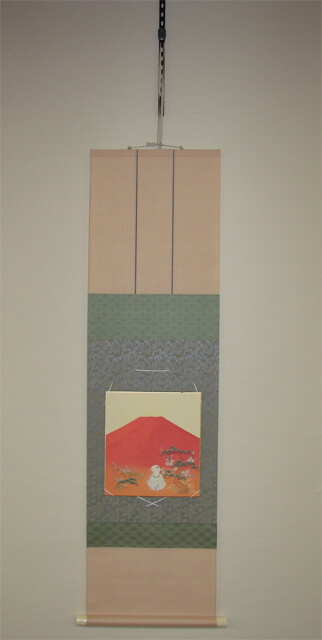Danger!! That Way of Hanging Could Make Your Scroll Fall!!

Contents
The Wrong Way to Use the Cord on a Kakejiku
At the top of a kakejiku (hanging scroll), there are two types of cords, each with a distinct name and purpose.
The first is called the kakeo (掛緒) — this cord is attached to the metal fittings on the semicircular wooden piece at the top of the scroll, known as the hassō (八双). The kakeo is the cord used to hang the scroll on a hook or nail.
The second cord, which is attached to the kakeo, is called the makio (巻緒). This longer cord is used only when rolling up the scroll for storage — it is wrapped around the scroll to keep it tightly secured.

However, a very common and dangerous mistake when displaying a kakejiku is to use this makio to create a loop, hang it on a hook or nail, and adjust the height — as shown in the example photo below. At first glance, this method may seem convenient, but in fact, it is extremely dangerous and can easily damage the scroll.

Why This Is Dangerous
If we look closely at the problem area, it looks like this:

The makio was never designed to support the weight of a hanging scroll. It is simply glued to the kakeo, and that junction is then wrapped and reinforced with a strip of fabric. This joint has only minimal strength, enough for storage purposes but not for hanging.

When you hang the kakejiku using the makio, the entire weight of the scroll is placed on this fragile joint, which can easily detach. As a result, the scroll can fall from the hook or nail, causing folds, dents, or tears on the artwork.

The Correct Way to Hang a Kakejiku
A kakejiku should always be displayed using the kakeo, not the makio. The kakeo is attached securely to metal fittings embedded in the hassō, which are strong enough to safely support the scroll’s full weight.


If you wish to adjust the display height of your kakejiku, you should not use the makio. Instead, use a proper adjustable hanging fixture called a jizaigake (自在掛).
With a jizaigake, you can easily slide the hook up or down by pinching it, allowing you to adjust the hanging height safely and neatly.

Recommended Tool: Jizaigake
The correct way to hang a scroll is as shown in the following photo.

If you often display kakejiku, it’s convenient to have at least one jizaigake. You can also purchase it through the following link:
In Summary
By correctly distinguishing between the kakeo and the makio, you can display your precious kakejiku safely and beautifully.
At ART NOMURA, we hope this guide helps you enjoy the refined beauty of traditional Japanese art safely and confidently.
Instruction Sheet



